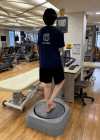Correlation Between Y-Balance Test and Balance, Functional Performance, and Outcome Measures in Patients Following ACL Reconstruction
- PMID: 35136688
- PMCID: PMC8805125
- DOI: 10.26603/001c.31873
Correlation Between Y-Balance Test and Balance, Functional Performance, and Outcome Measures in Patients Following ACL Reconstruction
Abstract
Background: The Y-Balance test (YBT) is commonly used to evaluate balance after anterior cruciate ligament reconstruction (ACLR). However, several studies have also used it as a functional performance test (FPT).
Purpose: This study aimed to examine the relationship between YBT scores and measures of knee joint laxity, static balance, knee flexor and extensor torque and strength ratio, and FPTs.
Study design: Retrospective cohort study.
Methods: Fifty-nine patients who underwent ACLR using hamstring autografts were retrospectively analyzed. The Pearson correlation coefficient was used to determine the strength of the association between scores on the YBT and selected outcomes including laxity measured via the KT-2000 arthrometer, static balance measured via the Biodex Balance System, isokinetic muscle torque and hamstring-to-quadriceps (HQ) ratio, and performance on the single leg hop test and the single leg vertical jump test.
Results: Forty-six men and 13 women were included. The mean age and follow-up period were 29.6 ± 9.6 years and 12.4 ± 2.1 months, respectively. The KT-2000 arthrometer measures, Biodex Balance System scores, and HQ ratio measurements were not significantly correlated with the YBT scores. All YBT scores, except the YBT-anterior score, correlated with the isokinetic extensor and flexor torques (r-values: 0.271-0.520). All the YBT scores had significant weak to moderate correlations with the single leg hop test and single leg vertical jump test scores: YBT-anterior (r = 0.303, r = 0.258), YBT-posteromedial (r = 0.475, r = 0.412), YBT-posterolateral (r = 0.525, r = 0.377), and YBT-composite (r = 0.520, r = 0.412).
Conclusion: Post-ACLR YBT scores correlated with functional performance and muscle strength, but not with static balance, joint laxity, and HQ ratios. The YBT scores as a measure of balance are related to improved functional performance and isokinetic torque measures.
Level of evidence: 3.
Keywords: anterior cruciate ligament reconstruction; balance; functional performance; muscle strength.
Conflict of interest statement
The authors declare that they have no potential conflicts of interest with respect to the research, authorship, or publication of this article.
Figures
Similar articles
-
Does a Lower Limb Balance Test after Anterior Cruciate Ligament Reconstruction Have a Significant Correlation with Postoperative Clinical Score, Stability, and Functional Performance Test?Clin Orthop Surg. 2023 Jun;15(3):402-409. doi: 10.4055/cios21218. Epub 2022 Nov 22. Clin Orthop Surg. 2023. PMID: 37274499 Free PMC article.
-
Y-Balance Test after ACL Reconstruction: The relationship with knee and hip muscle strength, ankle dorsiflexion range of motion and postural stability.J Bodyw Mov Ther. 2024 Oct;40:2099-2104. doi: 10.1016/j.jbmt.2024.10.016. Epub 2024 Oct 16. J Bodyw Mov Ther. 2024. PMID: 39593570
-
RELATIONSHIP BETWEEN THE LOWER QUARTER Y-BALANCE TEST SCORES AND ISOKINETIC STRENGTH TESTING IN PATIENTS STATUS POST ACL RECONSTRUCTION.Int J Sports Phys Ther. 2018 Apr;13(2):152-159. Int J Sports Phys Ther. 2018. PMID: 30090673 Free PMC article.
-
Correlation between hip muscle strength and the lower quarter Y-balance test in athletes following anterior cruciate ligament reconstruction.J Bodyw Mov Ther. 2024 Jan;37:188-193. doi: 10.1016/j.jbmt.2023.11.010. Epub 2023 Nov 20. J Bodyw Mov Ther. 2024. PMID: 38432805
-
Quadriceps Tendon Versus Hamstring Tendon Autografts for Anterior Cruciate Ligament Reconstruction: A Systematic Review and Meta-analysis.Am J Sports Med. 2022 Dec;50(14):3974-3986. doi: 10.1177/03635465211033995. Epub 2021 Sep 2. Am J Sports Med. 2022. PMID: 34470509
Cited by
-
Relationship of strength, joint kinesthesia, and plantar tactile sensation to dynamic and static postural stability among patients with anterior cruciate ligament reconstruction.Front Physiol. 2023 Jan 18;14:1112708. doi: 10.3389/fphys.2023.1112708. eCollection 2023. Front Physiol. 2023. PMID: 36744033 Free PMC article.
-
Impact of early vs. delayed physical therapy on functional recovery, proprioception, and return to sport after anterior cruciate ligament (ACL) reconstruction: a cross-sectional study.J Orthop Surg Res. 2025 Jul 12;20(1):644. doi: 10.1186/s13018-025-06054-x. J Orthop Surg Res. 2025. PMID: 40652287 Free PMC article.
-
Quadriceps Strength and Hamstring-to-Quadriceps Ratios in Pediatric Patients After ACL Reconstruction: Revisiting Norms from Adult Data.Orthop J Sports Med. 2025 Aug 15;13(8):23259671251360364. doi: 10.1177/23259671251360364. eCollection 2025 Aug. Orthop J Sports Med. 2025. PMID: 40823637 Free PMC article.
-
Functional Asymmetries After 6 Months of ACL Reconstruction: A Cross-Sectional Study.Int Wound J. 2025 Jul;22(7):e70715. doi: 10.1111/iwj.70715. Int Wound J. 2025. PMID: 40588423 Free PMC article.
-
The Effect of Mild Residual Rotational Laxity on Performance After Anterior Cruciate Ligament Reconstruction.Orthop J Sports Med. 2025 Jul 16;13(7):23259671251352205. doi: 10.1177/23259671251352205. eCollection 2025 Jul. Orthop J Sports Med. 2025. PMID: 40677899 Free PMC article.
References
-
- Does synovialization after anterior cruciate ligament reconstruction have a positive effect on functional performance, outcomes scores, stability and muscle strength? A 2-year follow-up study after reconstruction. Chung K. S., Ha J. K., Ra H. J., Kim S. B., Lee G. H., Kim J. G. 20171434-3916 (Electronic) 0936-8051 (Linking)Arch Orthop Trauma Surg. 137(12):1725–1733. doi: 10.1007/s00402-017-2808-6. - DOI - PubMed
-
- Safer and cheaper: An enhanced milestone-based return to play program after anterior cruciate ligament reconstruction in young athletes is cost-effective compared with standard time-based return to play criteria. DeFrancesco C. J., Lebrun D. G., Molony, J. T., Jr. Heath M. R., Fabricant P. D. 2020Am J Sports Med. 48(5):1100–1107. doi: 10.1177/0363546520907914. - DOI - PubMed
LinkOut - more resources
Full Text Sources
Research Materials



